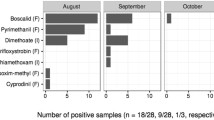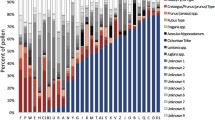Abstract
Pollination is one of the most important ecosystem services in agroecosystems and supports food production. Pollinators are potentially at risk being exposed to pesticides and the main route of exposure is direct contact, in some cases ingestion, of contaminated materials such as pollen, nectar, flowers and foliage. To date there are no suitable methods for predicting pesticide exposure for pollinators, therefore official procedures to assess pesticide risk are based on a Hazard Quotient. Here we develop a procedure to assess exposure and risk for pollinators based on the foraging behaviour of honeybees (Apis mellifera) and using this species as indicator representative of pollinating insects. The method was applied in 13 European field sites with different climatic, landscape and land use characteristics. The level of risk during the crop growing season was evaluated as a function of the active ingredients used and application regime. Risk levels were primarily determined by the agronomic practices employed (i.e. crop type, pest control method, pesticide use), and there was a clear temporal partitioning of risks through time. Generally the risk was higher in sites cultivated with permanent crops, such as vineyard and olive, than in annual crops, such as cereals and oil seed rape. The greatest level of risk is generally found at the beginning of the growing season for annual crops and later in June–July for permanent crops.







Similar content being viewed by others
References
Alix A, Vergnet C (2007) Risk assessment to honeybees: a scheme developed in France for non sprayed systemic compounds. Pest Manag Sci 63:1069–1080
Baird DJ, Van den Brink PJ (2007) Using biological traits to predict species sensitivity to toxic substances. Ecotoxicol Environ Saf 67:296–301
Barmaz S (2009) Plant protection product risk assessment: distribution and experimental validation in terrestrial ecosystems. PhD Thesis, Università degli Studi Milano-Bicocca. http://hdl.handle.net/10281/7503. Accessed 22 Jan 2010
Becker FA, Klein AW, Winkler R, Jung B, Bleiholder H, Schmider F (1999) The degree of ground coverage by arable crops as a help in estimating the amount of spray solution intercepted by the plants [Bodendeckungsgrade bei Flächenkulturen als Hilfsmittel zum Abschätzen der Interzeption von Spritzflüssigkeiten]. Nachrichtenbl Deut Pflanzenschutz 51(9):237–242
Biesmeijer JC, Roberts SPM, Reemer M, Ohlemüller R, Edwards M, Peeters T, Schaffers AP, Potts SG, Kleukers RC, Thomas D, Settele J, Kunin WE (2006) Parallel declines in pollinators and insect-pollinated plants in Britain and the Netherlands. Science 313(5785):351–354. doi:10.1126/science.1127863
Boedeker W, Drescher K, Altenburger R, Faust M, Grimme LH (1993) Combined effects of toxicants: the need and soundness of assessment approaches in ecotoxicology. Sci Total Environ Suppl 2:931–939
Bostanian NJ, Belanger A, Boudreau F, Mailloux G (1993) Dissipation of cyhalothrin residues on apple foliage and apple at harvest. J Agric Food Chem 41(2):292–295. doi:10.1021/jf00026a031
Calliera M, Balderacchi M, Capri E, Trevisan M (2008) Prediction of agrochemical residues data on fruit using an informatic system (PARDIS model). Pest Manag Sci 64(10):981–988
Corine Land Cover (2000) Data download for year 2000, European Environmental Agency website. http://www.eea.europa.eu/themes/landuse/clc-download. Accessed Jul 2009
De Lange HJ, Sala S, Vighi M, Faber JH (2009) Ecological vulnerability in risk assessment—a review and perspectives. Sci Total Environ. doi:10.1016/j.scitotenv.2009.11.009
Drescher K, Boedeker W (1995) Assessment of the combined effects of substances: the relationship between concentration addition and independent action. Biometrics 51:716–730
EC (2002) Guidance Document on Terrestrial Ecotoxicology Under Council Directive 91/414/EEC. SANCO/10329/2002 rev 2 final. http://ec.europa.eu/food/plant/protection/resources/publications_en.htm. Accessed 14 Jul 2010
Faust M, Altenburger R, Backhaus T, Blanck H, Bödeker W, Gramatica P, Hamer V, Scholze M, Vighi M, Grimme LH (2003) Joint algal toxicity of 16 dissimilarly acting chemicals is predictable by the concept of independent action. Aquat Toxicol 63(1):43–63
Finizio A, Villa S, Vighi M (2005) Predicting pesticide mixtures load in surface waters from a given crop. Agric Ecosyst Environ 111:111–118
FOCUS (2003a) FOCUS surface water scenarios in the EU evaluation process under 91/414//EEC. Report of the FOCUS Working Group. http://focus.jrc.ec.europa.eu/index.html. Accessed 14 Jul 2010
FOCUS (2003b) Foliar Washoff coefficient. In: FOCUS surface water scenarios in the EU evaluation process under 91/414//EEC. Final Report. p 202. http://focus.jrc.ec.europa.eu/index.html. Accessed 14 Jul 2010
FOOTPRINT (2006) The FOOTPRINT Pesticide Properties DataBase. Database collated by the University of Hertfordshire as part of the EU-funded FOOTPRINT project (FP6-SSP-022704). http://www.eu-footprint.org/ppdb.html. Accessed Jul 2009
Gallai N, Salles JM, Settele J, Vaissière BE (2009) Economic valuation of the vulnerability of world agriculture confronted with pollinator decline. Ecol Econ 68:810–821
Ganzelmeier H, Rautmann D, Spangenberg R, Streloke M, Herrmann M, Wenzelburger HJ, Water HF (1995) Studies on the spray drift of plant protection products. Result of a test program carried out throughout the Federal Republic of Germany. Blackwell Wissenschafts Verlag BmbH, Berlin
Ghazoul J (2005) Buzziness as usual? Questioning the global pollination crisis. Trends Ecol Evol 20:367–373
Hammen VC et al (2009) Establishment of a cross-European field site network in the ALARM project for assessing large-scale changes in biodiversity. Environ Monit Assess. doi:10.1007/s10661-009-0896-7
Junghans M, Backhaus T, Faust M, Scholze M, Grimme LH (2006) Application and validation of approaches for the predictive hazard assessment of realistic pesticide mixtures. Aquat Toxicol 76:93–110
Klein AM, Vaissière BE, Cane JH, Steffan-Dewenter I, Cunningham SA, Kremen C, Tscharntke T (2007) Importance of pollinators in changing landscapes for world crops. Proc R Soc B 274:303–313. doi:10.1098/rspb.2006.3721
Kremen C et al (2007) Pollination and other ecosystem services produced by mobile organisms: a conceptual framework for the effects of land-use change. Ecol Lett 10(4):299–314
Leistra M (2005) Estimating input data for computations on the volatilisation of pesticides from plant canopies and competing processes. Alterra-rapport 1256—Alterra, Wageningen. http://www2.alterra.wur.nl/Webdocs/PDFFiles/Alterrarapporten/AlterraRapport1256.pdf. Accessed 23 Jan 2010
Lonsdorf E, Kremen C, Ricketts T, Winfree R, Williams N, Greenleaf S (2009) Modelling pollination services across agricultural landscapes. Ann Bot 103(9):1589–1600. doi:10.1093/aob/mcp069
OEPP/EPPO (2003) Environmental risk assessment scheme for plant protection products. Chapter 10. Bull OEPP/EPPO 33:141–145. http://archives.eppo.org/EPPOStandards/PP3_ERA/pp3-10%282%29.pdf. Accessed 23 Jan 2010
Otto S, Lazzaro L, Finizio A, Zanin G (2009) Estimating ecotoxicological effects of pesticide drift on non target arthropods in field hedgerows. Environ Toxicol Chem 28(4):853–863
Pappas CJ, Kyriakidis NV (2003) A comparison of dimethoate degradation in lemons and mandarins on the trees with two GC systems. Food Chem 80(1):23–28
Pinzauti M, Frediani D, Biondi C, Belli R, Panizzi L, Cosnimi C, Zummo V (1991) Uses of honeybees for monitoring environmental pollution (in Italian). Analysis 8:355–405
Rautmann D, Streloke M, Winkler R (2001) New basic drift values in the authorization procedure for plant protection products. Mitt Biol Bundesanst Land-Forstwirtsch. No. 383. Berlin
Ricketts TH, Regetz J, Steffan-Dewenter I, Cunningham SA, Kremen C, Bogdanski A, Gemmill-Herren B, Greenleaf SS, Klein AM, Mayfield MM, Morandin LA, Ochieng A, Potts SG, Viana BF (2008) Landscape effects on crop pollination services: are there general patterns? Ecol Lett 11:499–515
Rortais A, Arnold G, Halm MP, Touffet-Briens F (2005) Modes of honeybee’s exposure to systemic insecticides: estimated amounts of contaminated pollen and nectar consumed by different categories of bees. Apidologie 36:71–83. doi:10.1051/apido:2004071
Seeley TD (1985) Honeybee ecology. A study of adaptation in social life. Princeton University Press, Princeton
Settele J et al (2005) ALARM: assessing large-scale environmental risks for biodiversity with tested methods. GAIA Ecol Perspect Sci Soc 14(1):69–72
Smit AAMFR, Leistra M, Van Den Berg F (1998) Estimation method for the volatilisation of pesticides from plants. Environmental Planning Bureau Series 4. DLO Winand Staring Centre, Wageningen
Solomon KR, Giesy JP, Kendall RJ, Best LB, Coats JR, Dixon KR, Hooper MJ, Kenaga EE, McMurry ST (2001) Chlorpyrifos: ecotoxicological risk assessment for birds and mammals in corn agroecosystems. Hum Ecol Risk Assess 7(3):497–632
Tarazona JV, Hund K, Jager T, S-Salonen M, Soares AMVM, Skaare JU, Vighi M (2002) Standardizing chemical risk assessment, at last. Nature 415(6867):14
Thompson HM, Hunt LV (1999) Extrapolating from honeybees to bumblebees in pesticide risk assessment. Ecotoxicology 8(3):147–166. doi:10.1023/A:1026444029579
Tomlin CDS (ed) (2003) The pesticide manual: a world compendium, 13th edn. British Crop Protection Council, Farnham, UK
Tremolada P, Bernardinelli I, Colombo M, Serafico M, Vighi M (2004) Coumaphos distribution in the hive ecosystem: a case of study for modelling application. Ecotoxicology 13(6):589–601. doi:10.1023/B:ECTX.0000037193.28684.05
Verro R, Finizio A, Otto S, Vighi M (2009) Predicting pesticide environmental risk in intensive agricultural areas. II: screening level risk assessment to complex mixtures in surface waters. Environ Sci Technol 43(2):530–537
Vighi M, Garlanda MM, Calamari D (1991) QSARs for toxicity of organophosphorus pesticides to Daphnia and honeybees. Sci Total Environ 109–110:605–622
Winfree R, Aguilar R, Vázquez DP, LeBuhn G, Aizen MA (2009) A meta-analysis of bees’ responses to anthropogenic disturbance. Ecology 90(8):2068–2076. doi:10.1890/08-1245.1
Acknowledgments
The Authors would like to thank all the Field Site Managers and Assistant of ALARM project, Mr. Oddino Bin and all the people that collaborate in data collection. A special mention is also for the meteo-offices that provided rain fall data, in particular ARPAV, UK Met Office and all the other local stations. Thanks to Dr. Stefan Otto for suggestions and agronomical data and to Prof. Mario Colombo, Dr. F. Romana Eordegh and Dr. Iris Bernardinelli for entomological data. The PhD grant of S. Barmaz is supported by Syngenta Crop Protection. Research supported by the European Commission, Contract no. 506675, ALARM.
Author information
Authors and Affiliations
Corresponding author
Rights and permissions
About this article
Cite this article
Barmaz, S., Potts, S.G. & Vighi, M. A novel method for assessing risks to pollinators from plant protection products using honeybees as a model species. Ecotoxicology 19, 1347–1359 (2010). https://doi.org/10.1007/s10646-010-0521-0
Accepted:
Published:
Issue Date:
DOI: https://doi.org/10.1007/s10646-010-0521-0




